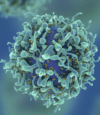Month: February 2020
-

Improved Beta Cell Function of Transplanted Islet Cells in T1D
One of the major challenges of using transplanted islet cells in the treatment of type 1 diabetes is cell death. Due to cellular stressors, poor oxygenation or vascularization, autoimmune response, […]
-

Type 1 Diabetes Vaccine Shows Positive Results
In an effort to prevent or delay the onset of type 1 diabetes, researchers have been striving to create an effective vaccine. One of the challenges is that there are […]
-

Improved Protection for Transplanted Stem Cell-Derived Islets
Insulin-producing beta cells are essential for effective blood sugar control. However, in individuals with type 1 diabetes, these cells are mistakenly destroyed by the immune system. That means exogenous insulin […]
-

Exploring Why the Immune System May Attack Insulin-Producing Beta Cells
Insulin-producing beta cells are essential for effective blood sugar control. However, in individuals with type 1 diabetes, these cells are mistakenly destroyed by the immune system. That means exogenous insulin […]
-

Understanding the Impact of GABA on Insulin Secretion and Regulation
In order to manage blood glucose levels, pancreatic beta cells release insulin in pulses. These bursts of insulin help the body to regulate and stabilize blood sugar. In individuals with […]
